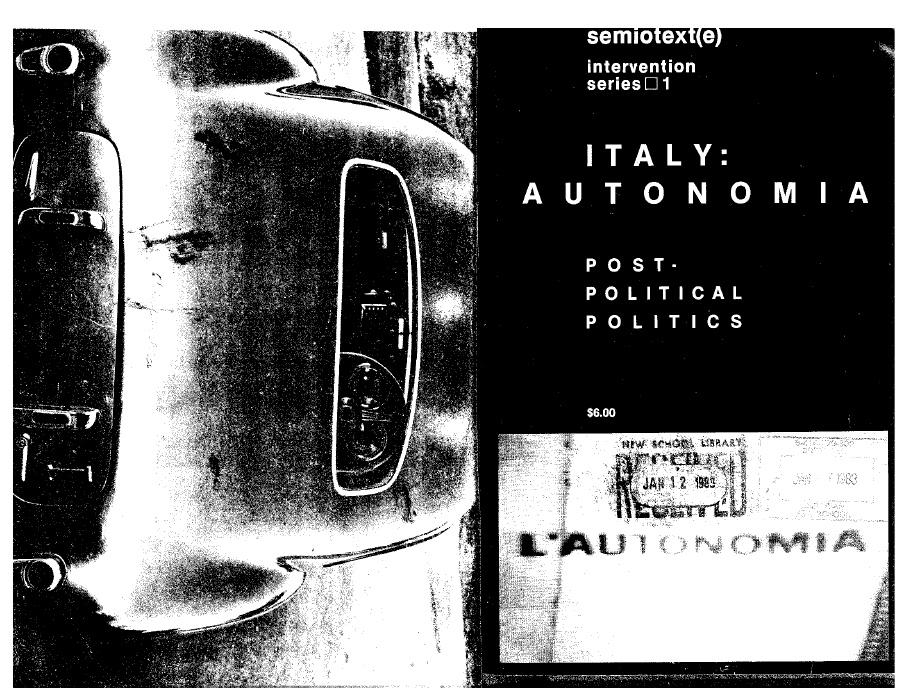Semiotext(e) 3(3): Autonomia: Post-Political Politics (1980)
Filed under magazine | Tags: · autonomy, italy, politics, proletariat, protest, social movements, society, work

“Semiotext(e)’s legendary magazine issue Italy: Autonomia: Post-Political Politics. Edited by Sylvère Lotringer and Christian Marazzi with the direct participation of the main leaders and theorists of the Autonomist movement (including Antonio Negri, Mario Tronti, Franco Piperno, Oreste Scalzone, Paolo Virno, Sergio Bologna, and Franco Berardi), this volume is the only first-hand document and contemporaneous analysis that exists of the most innovative post-’68 radical movement in the West. The movement itself was broken when Autonomia members were falsely accused of (and prosecuted for) being the intellectual masterminds of the Red Brigades; but even after the end of Autonomia, this magazine remains a crucial testimony of the way this creative, futuristic, neo-anarchistic, postideological, and nonrepresentative political movement of young workers and intellectuals anticipated issues that are now confronting us in the wake of Empire.”
Edited by Sylvère Lotringer and Christian Marazzi
Publisher Semiotext(e), New York
Intervention series, 1 / Foreign Agents series
ISSN 1584350539, 9781584350538
xvi+300 pages
via Stevphen Shukaitis
PDF (8 MB, updated on 2017-6-26)
Comment (0)Alessandro Colizzi: Bruno Munari and the Invention of Modern Graphic Design in Italy, 1928-1945 (2011)
Filed under thesis | Tags: · 1920s, 1930s, 1940s, art, avant-garde, constructivism, design, futurism, graphic design, italy, painting, typography

“Despite the difficult political conditions under the Fascist regime, Italy saw its own modernist wave hit the commercial arts in the 1930s, resulting from a complex interplay of factors as diverse as the weight of Futurism, the rise of advertising, and the debate surrounding Rationalist architecture. This research examines Bruno Munari’s work as a graphic designer from the late 1920s to mid-1940s, with the aim of understanding the emergence and characteristics of the modernist trend in Italian graphic design. Taking shape in Milan, this original ‘design culture’ eclectically brought together two quite different strains of Modernity: a local tradition represented by the Futurist avant-garde, and a European tradition associated with Constructivism. Munari (1907–1998) worked simultaneously as painter and as advertising designer: he debuted with the Futurists, whose broader cultural reach he shared, while also remaining open to other currents—such as Dadaism and Surrealism—and ultimately aligned himself with a more Abstractionist stance. Insofar as he was an exponent of the new advertising profession, his design work also reflects its evolution, mixed references, aspirations, and limits. Concentrating on Munari’s stylistic development, the study seeks to explore the interaction between the Futurist visual vocabulary and conceptions coming from architecture, photography, abstract painting, and functionalist typography trickling in from central and northern Europe. Hence, the discussion positions the designer in his time and place, concentrating as much on the artefacts as on the broader cultural framework. Secondly, the study attempts to assess Munari’s reputation against a body of exemplary work, based on firsthand documentation. It is the first extensive, detailed record of Munari’s graphic design output, and as such provides a substantial base for a full understanding of his œuvre. While Munari’s evolution is dealt with chronologically, the analysis of his graphic works highlights key areas of visual interest, offering a cross reading that sheds light on their underlying poetics, themes, and formal attributes. In its trajectory, Munari’s wide-ranging graphic design work shows how modernist ideas were received and assimilated in the Milanese environment of the 1930s, as well as the shift in conceptions of the graphic design profession—from one related to avant-garde art practice to a Modern one, based on rational idioms. The roots of modern Italian graphic design, which fully emerged after 1945, can be traced to this heterogeneous legacy—and it is no coincidence that Munari became one of the fields’ leading exponents.” (Abstract)
Doctoral Thesis
Faculty of Humanities, Leiden University Academy of Creative and Performing Arts
Promotor: G. Unger
Co-promotor: T.M. Eliëns
PDF (Works section missing)
PDFs
Pier Vittorio Aureli: The Project of Autonomy: Politics and Architecture Within and Against Capitalism (2008)
Filed under book | Tags: · 1960s, 1970s, architecture, autonomy, capitalism, italy, operaismo, politics, theory

“The Project of Autonomy radically rediscusses the concept of autonomy in politics and architecture by tracing a concise and polemical argument about its history in Italy in the 1960s and early 1970s. Architect and educator Pier Vittorio Aureli analyzes the position of the Operaism movement, formed by a group of intellectuals that produced a powerful and rigorous critique of capitalism and its intersections with two of the most radical architectural-urban theories of the day: Aldo Rossi’s redefinition of the architecture of the city and Archizoom’s No-stop City. Readers are introduced to major figures like Mario Tronti and Raniero Panzieri who have previously been little known in the English-speaking world, especially in an architectural context, and to the political motivations behind the theories of Rossi and Archizoom. The book draws on significant new source material, including recent interviews by the author and untranslated documents.”
Publisher Princeton Architectural Press, 2008
Volume 4 of Buell Center/FORuM Project publication
ISBN 1568987943, 9781568987941
88 pages

